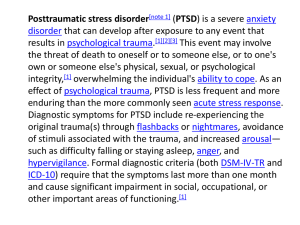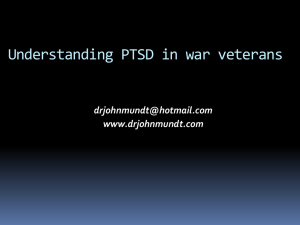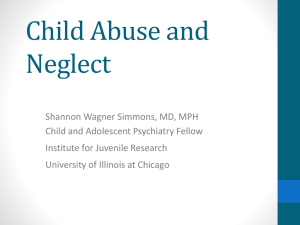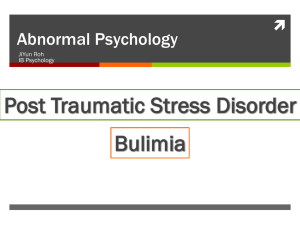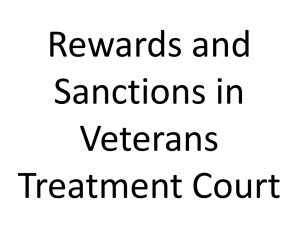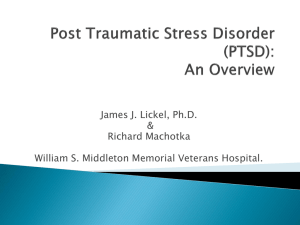PTSD: From Assessment to Treatment
advertisement
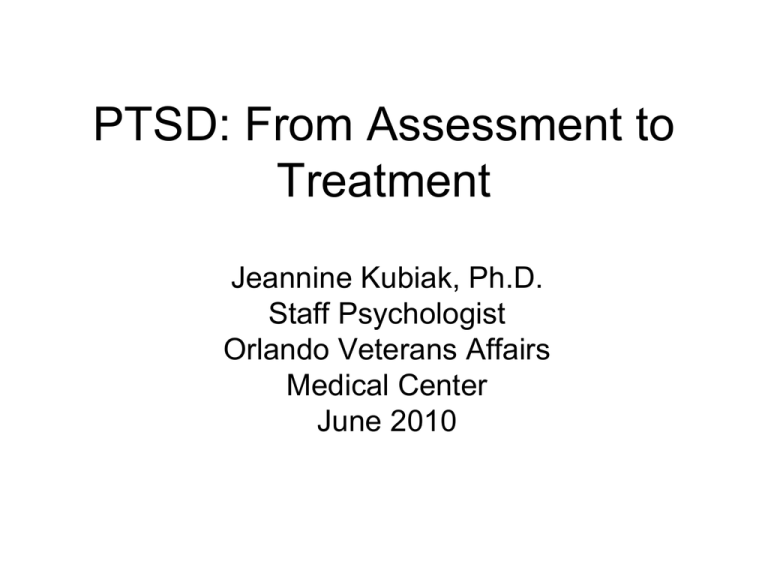
PTSD: From Assessment to Treatment Jeannine Kubiak, Ph.D. Staff Psychologist Orlando Veterans Affairs Medical Center June 2010 Nosological History • VA diagnostic manual included psychological manifestations exhibited by veterans • Diagnostic and Statistical Manual of Mental Disorders (1952) – Gross Stress Reaction covered victims of stress • Diagnosis dropped from DSM-II (1968) • DSM-III (1980) christened the name Post-Traumatic Stress Disorder – Traumatic event: a catastrophic stressor that was outside the range of usual human experience • War, torture, rape, atomic bombings, natural disasters, man-made disasters (airplane crash, industrial explosion, motor vehicle accident) • Did not encompass normal life stressors such as divorce, serious illness, financial problems DSM-IV (1996) and DSM-IV-TR (2000) • Exposure to “a traumatic event” • Exposure by – Direct personal experience – Witnessing – Learning about (family member or “other close associate”) Traumatic Event under DSM-IV-TR • Examples of traumatic event : – being diagnosed with a life-threatening illness – learning that one’s child has a life-threatening illness – seeing a dead body or body parts – generalized fear of death or injury – severe verbal abuse – For children, a parent’s death Necessary criteria • Response to the stressor must involve: – Intense fear – Helplessness OR – Horror – Children: disorganized or agitated behavior • Persistent re-experiencing of the traumatic event • Persistent avoidance of stimuli associated with the trauma • Numbing of general responsiveness • Persistent symptoms of increased arousal RE-EXPERIENCING • • • • • Distressing recollections Distressing dreams Flashbacks – psychotic reenactments Sense of reliving the event Exposure to mimetic stimuli – Intense psychological distress – Physiological reactivity AVOIDANCE • • • • Conversation Activities, locations, people Inability to recall important aspect of trauma Markedly diminished interest or participation in significant activities • Feeling detached or estranged from others • Restricted range of affect • Sense of foreshortened future INCREASED AROUSAL • • • • • Sleep disturbance Irritability or anger outbursts Difficulty concentrating Hypervigilance Exaggerated startle response • Full symptom picture must be present for more than 1 month • The disturbance must cause clinically significant distress or impairment in social, occupational or other important areas of functioning. Specifications • Acute: symptoms last less than 3 months • Chronic: symptoms last 3 months or more • Delayed onset: onset of symptoms is at least 6 months after the stressor Prevalence Rates • Exposure to trauma in America: – Men 8.1% – Women 20.4% • PTSD: – Men 5% – Women 10.4% Sexual Assault • Women have greater chance of exposure to interpersonal trauma – Rape – Sexual molestation • Rape prevalence: men .7%; women 9.2% • PTSD from rape: men 65%; women 45.9% Combat/Terrorism • Exposure to military combat • Witnessing someone being critically injured or killed • Current VA: being exposed to an environment in which one fears for their safety • Military combat PTSD increasing among women IN THE EYE OF THE BEHOLDER • Event occurs • Person “makes sense” of event through cognitive and emotional processes • Appraisal occurs • Adjustment occurs • Functionality occurs • Mental health/illness occurs Common Precursors • • • • • • • Learning disabilities Physical abuse Sexual abuse Existence of a mental disorder Substance Abuse/Dependence Unstable childhood Custodial parent with PTSD Impacts • Duration of the traumatic event • Traumatic event inflicted by a person • Violence associated with the trauma • Previous traumatic event(s) Comorbidity • National Comorbidity Study: 88.3% men and 79% women diagnosed with PTSD have at least one comorbid psychiatric disorder. – Depression – Substance Abuse/Dependence – Anxiety Disorder Post-PTSD • Depression – Men 6.9 times – Women 4.1 times • Mania – Men 10.4 times – Women 4.5 times Substance Abuse • Estimated that about 35% of men with PTSD have or develop substance abuse problems • Estimate for women is about 27% Substance Abuse • Intoxication is hypothesized to dull the sense of fear and inability to cope • Fear response does not extinguish • Fear response continues SUICIDE • U.S. suicide rate higher in men than women – 23.19 per 100k v. 5.65 per 100k • Rate of attempted suicide is 20% for people diagnosed with PTSD • 90% of suicides are by people diagnosed with a mental illness FEAR RESPONSE • Normal fear response: immediate sympathetic discharge activates “fight or flight” reaction. • Limbic system: Amygdala and hippocampus • Catecholamines and cortisol increase relative to the severity of the stressor. • Cortisol acts in a negative feedback loop to suppress sympathetic activation and cause further release of cortisol. Memory Circuits • Amygdala – limbic structure involved in emotion, learning and memory. Processes “reflexive” emotions like fear and anxiety. • Hippocampus – plays a significant role in the formation of long-term memories. PHARMACOLOGIC TREATMENT • SSRI’S are the mainstay of pharmacologic treatment of PTSD. – Zoloft (sertraline) and Paxil (paroxetine) only FDA-approved medications for treatment of PTSD Mood Stabilizers •divalproex (Depakote and Depakote ER) •carbamazepine (Carbatrol, Equetro, Tegretol) •lamotrigine (Lamictal) •topiramate (Topamax) Medications for PTSD/SA • Sertraline: improves early PTSD and ETOH • Disulfiram: improves ETOH and PTSD • Naltrexone: decreases ETOH relapse, no effect on PTSD • Risperidone: combined with SSRI effective in PTSD, combined with Naltrexone effective for ETOH • Valproate: no effect on PTSD, effective in ETOH detox OPIOIDS/BENZODIAZEPINES • Create tolerance and dependence • Analgesic effect for deep pain (e.g., back and neck pain) is dampened • Opioid-induced hyperalgesia: minimal pain triggers a full pain effect (usually occurs through suboptimal dosing) • Use is contraindicated if there is substance abuse • No evidence they are useful in PTSD treatment Atypical Antipsychotics • 10% of patients with PTSD receive antipsychotic medication to treat the PTSD symptoms – Symptoms tend to be more intrusive and severe – Used to augment SSRI’s – Risperidone effective for flashbacks (psychotic re-experiencing) and nightmares – Olanzapine and quetiapine EVIDENCE-BASED TREATMENTS • Cognitive-behavioral therapies • Avoidance is necessary component of development and prolongation of PTSD • Based on hypothesis of inability to tell the difference between the traumatic event and safety in the current environment • Develop anxiety-management skills Prolonged Exposure Therapy • Edna Foa, Ph.D., University of Pittsburgh • Uses sustained exposure to reduce fear response to trauma-related stimuli • Imaginal exposure • In-vivo exposure Cognitive Restructuring • Correcting the distorted appraisal process • Reduces perception of danger in neutral and innocuous situations Seeking Safety • Lisa Najavits, Ph.D., Harvard Medical School • Group therapy for PTSD with comorbid substance abuse • Psychoeducation • Exposure • Cognitive processing Acceptance and Commitment Therapy • Robyn Walser and Darrah Westrup • Focus on concept of “mindfulness” • Emphasizes acceptance of internal phenomena and on valued living • Helps client to see that reactions are internal phenomena • Goal is to experience internal phenomena and learn to view them differently Resistance to PTSD • High-stress careers (fire, police, EMT, ER) attract people more normally resistant to traumatization • Effects of preparedness training FUTURE • Trauma response can be passed down through the generations, (children of holocaust survivors) • Children who witness parental violence can have PTSD even if they are not the targets of the violence. • DSM-V, due in May of 2012, will reflect the latest research on PTSD.
